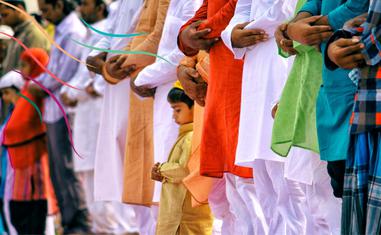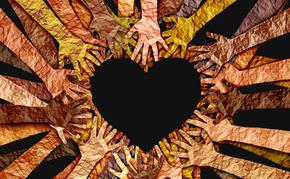The views expressed in our content reflect individual perspectives and do not represent the authoritative views of the Baha'i Faith.
Now that we’ve learned a little about Hindu beliefs in the earlier essays in this series, we’re almost ready to meet our Hindu neighbors.
First, though, we’ll need to learn a bit more about Brahman and a few similar-sounding words. Why would you want to do that? Because, as the Baha’i teachings say, and as Abdu’l-Baha wrote:
Today the one overriding need is unity and harmony among the beloved of the Lord, for they should have among them but one heart and soul and should, so far as in them lieth, unitedly withstand the hostility of all the peoples of the world; they must bring to an end the benighted prejudices of all nations and religions and must make known to every member of the human race that all are the leaves of one branch, the fruits of one bough.
In that spirit of oneness, Baha’is believe, we can approach people of all faiths by understanding the essential oneness of religion.
RELATED: How to Understand a Hindu Idol
Hindus sometimes face disapproval in Western countries because they have an exalted concept of God within. For Hindus, the God within us is called “Atman”—a word which basically means the self—and it is and is not Brahman [God].
It is Brahman (and the Brihadaranyaka Upanishad says it is—see 4.4.5) in the sense that it is not other than Brahman. The being we feel inside us is divine. We are created, the Bible affirms, in the image of God and His image is within us. But we are not the whole of God; we reflect a tiny part, and that part Hindus know as Atman.
There is another similar word in Sanskrit: Brahma. In much the same way that Westerners sometimes draw a distinction between God and His word or will—the divine logos—Hindus often distinguish between the unchanging Brahman and Brahma, a derivative force who created the world and from which humanity is evolved.
Brahman is formless and genderless; Brahma is often given a male form, married to Saraswati, and is usually portrayed as four-faced, one facing in each direction. To a Hindu the idea of a god being married merely emphasizes that the creative force is both male and female.
Brahma is part of what is sometimes called the Hindu Trinity (Trimurthi) of high gods: Brahma, Vishnu and Shiva. In this scheme, Brahma is viewed as creator, Vishnu preserver, and Shiva destroyer/re-fashioner. (The related word “Brahmin,” by the way, refers to a Hindu priest or members of the priestly class.)
The Complexity of the Hindu View of God
Only some Hindus call the creator God Brahma. Use of the term is not as common as we might think. Rather, what God is called depends largely on where you grew up in India, or into which family you were born. Some Hindus call the Supreme God Shiva (or Siva), others Vishnu, others Devi (or the Goddess).
That, however, will be easier to determine once we meet your Hindu neighbors. For now, just try to remember that there are four main branches of Hinduism: Vaishnavism, Saivism, Shaktism, and Smartism. We’ll focus on the first three.
The Visit: Deciphering Denominations
Ok, now we’re ready to venture forth to meet your neighbors. Know that your neighbors, as practicing Hindus, are sworn to ten spiritual attributes, called Vedic Restraints or yamas, found in the Shandilya and Varuha Upanishads: Non-injury, truthfulness, non-stealing, sexual restraint and modesty (bramacharya), patience, steadfastness, compassion, honesty, moderation, and purity. In short, they commit to having good character, so relax—you will be welcomed and well-treated when you meet your Hindu neighbors.
Bring flowers or sweets, not meat dishes; most Hindus are vegetarians. Also, give your gifts inside the house, or outside if the host comes out to greet you—many Hindus view it as impolite to linger in a doorway. Just follow their lead. You may need to leave your shoes at the door.
RELATED: Consorting with the Followers of All Religions
One of the first things you may see—more likely on the ladies of the house, although men can wear them too—is a dot on the forehead, usually just over and between the eyebrows. It may not mean anything to the woman wearing it save that it’s a Hindu custom and she likes it. Generally, however, it symbolically represents the “third eye:” the importance of seeing spiritual qualities, not just physical qualities. This little mark is called a bindi in the Hindi language, and pottu in the Tamil language spoken in southern India. Traditionally, a red dot meant the wearer was married, and a black dot meant they were not, but the color may now simply mean that the wearer likes that color.
In general, forehead marks are called tilaka in Sanksrit (Tilak in Hindi), which means a “mark” or “freckle,” but they can be more dramatic than the simple bindi. On men you may see lines that run vertically from the hair-line above the forehead running down toward the eye-brows looking like a “V” or “U”-shaped necklace, sometimes with a dot or flame inside or a pendant-looking thing on the bridge of the nose. Usually in the West, you’d only see this on special religious occasions or if you encountered a Hindu priest. If you did see it, you’d know that your neighbors are Vaishnavites and that they call their Supreme God Vishnu.
If, instead of vertical lines on the forehead, you see horizontal lines (usually three on top of each other), you have discovered that the family is Shaivite and that they call their Supreme God, Siva (a.k.a. Shiva). Those three lines represent the three things that bind the soul, and from which Saivites seek to be released: ego (anava), bad deeds (bad karma) and delusion (maya).
If you saw a single line or a rectangle on the forehead, the wearer would probably be a Shakta—a follower of Shaktism, and their name for the Supreme Being would be Shakti or Devi, the latter meaning the Goddess.
All of these traditional markings, though, mean something larger and more important—that you’ve just met a person of faith, someone who lives by an ancient and venerable tradition of self-awareness and self-improvement, just like Baha’is.

















Comments
Sign in or create an account
Continue with Facebookor